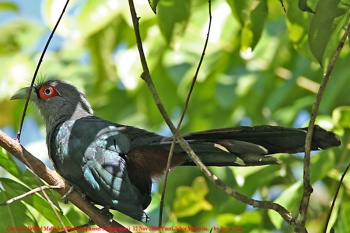- Phaenicophaeus sumatranus
Identification
40–41 cm (15¾-16 in)
- Dark grey back and underparts
- Large orangy-red eye ring
- Chestnut belly
- Dull turquoise wings
- Greenish-grey bill
Distribution
South-east Asia: found in southern Myanmar, southern Thailand, Malay Peninsula, Sumatra and Borneo.
Taxonomy
This species is often seen as monotypic[1], however, some authorities recognize three subspecies: sumatranus, minor, and rodolphi[2].
Some authorities place it in a different genus as Rhopodytes sumatranus[2].
Habitat
Mangroves, broadleaved evergreen forest and forest edges up to 1,000m.
Behaviour
Breeding
The nest is a platform of twigs, placed in the fork of a tree.
Diet
The diet includes lizards, grasshoppers and caterpillars.
References
- Clements, J. F., T. S. Schulenberg, M. J. Iliff, D. Roberson, T. A. Fredericks, B. L. Sullivan, and C. L. Wood. 2017. The eBird/Clements checklist of birds of the world: v2017, with updates to August 2017. Downloaded from http://www.birds.cornell.edu/clementschecklist/download/
- Avibase
- BESGroup
- Handbook of the Birds of the World Alive (retrieved Mar 2018)
Recommended Citation
- BirdForum Opus contributors. (2024) Chestnut-bellied Malkoha. In: BirdForum, the forum for wild birds and birding. Retrieved 9 November 2024 from https://www.birdforum.net/opus/Chestnut-bellied_Malkoha
External Links
GSearch checked for 2020 platform.1






